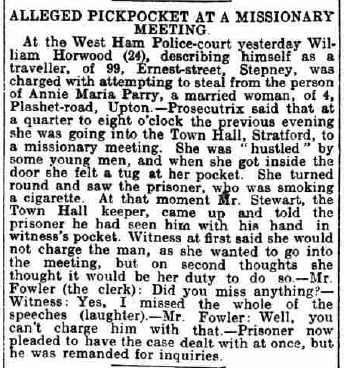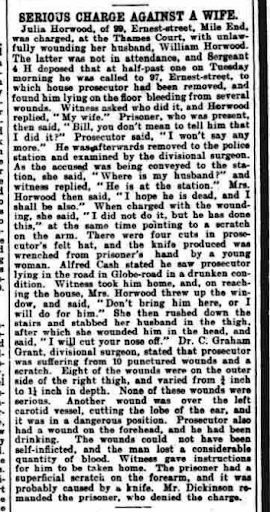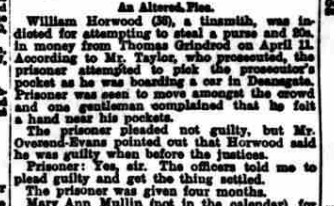b.1872-d.1915
William Horwood was buried in Horton Cemetery on 20th April 1915. Workhouse records document his admission to Mile End Workhouse, Bancroft Road, Bethnal Green on 23rd March 1912 and his discharge to Long Grove Asylum on 29th March. His age was recorded as 40, his occupation as ‘Cabinetmaker’ and his religion as ‘CofE’. The remark ‘Deemed Insane’ was entered against his name under Observations.
The Lunacy Patients Admission Register confirms that he was admitted to Long Grove Asylum on the 29th March and records that he died there on the 15th April 1915. His death certificate gives the cause of death as General Paralysis of the Insane (GPI) and Pulmonary Tuberculosis.

His previous address is given as 27 Duckett Street, Mile End; his age as 42; and his occupation as Fancy Goods Traveller.
Identifying William in other records and distinguishing him from other men of the same name has been challenging. It appears that he was the son of John Pinder Horwood b.1852, a furrier, and Elizabeth Cox b. 1851. He was baptised at St James the Great, Bethnal Green on 17th March 1872. The baptismal record also records his date of birth which was 21st February of the same year. The family’s address is given as 2 Margaret Place, Shoreditch.
The 1881 Census has the Horwoods living at 6 Scott Street, Bethnal Green, which was just north of the Mile End Road and south of the Great Eastern Railway running into Liverpool Street Station. Nine-year-old William has three siblings – Elizabeth b.1875, Henry b.1878 and John b.1880. The house is shared with another couple, with one child, and a widow.
First of many court appearances
Sadly, the next time that William is found in an official record it is at Marlboro’ Police Court where he is convicted of ‘stealing a purse from person’, on 21st January 1890 and sentenced to 3 months imprisonment. It is noted that he was using the alias George Costello. This is the first of many convictions recorded in the annual UK Calendar of Prisoners.
By the time of the 1891 Census, Emily b.1882, Harriett b.1885 and Caroline Rebecca b.1888 had been added to the family, who are now living at 45 Jacob Street, Bethnal Green. They share with four other households comprising six adults and two children.
Caroline Rebecca had been born in the Whitechapel workhouse infirmary and Poor Law removal and settlement records detail the nine or so addresses in Shoreditch, Bethnal Green and Whitechapel that the family moved between over the next decade.
John Pinder’s occupation is initially given as furrier but later he is described as a dock labourer, although he often seems to be out of work, and in the 1891 census his occupation is given as a hawker or street trader.
William is missing from the family in the 1891 Census. This is explained by his second court appearance at the North London Sessions on 3rd November 1890, when he was sentenced to 12 months for stealing a watch. On this occasion, he used the alias William Wooding and his occupation is given as bookmaker. He appears in the 1891 Census under the same name in Wormwood Scrubs prison. His occupation has now changed to bootmaker.
William marries Julia Costello
Following his release from prison in November 1891, we next find him not in court but at St Olave’s Church in the City of London, where he married Julia Costello on 4th April 1892. His occupation is given as a commercial traveller, as is that of his father. Possibly this is a polite version of hawker.
Julia Costello b. Q4 1872 in Whitechapel was the daughter of Patrick Costello, a tailor, and Ann, a tailoress, both born in Cork, Ireland. She has a number of possible siblings – earlier records may not be completely reliable. The 1881 Census, when the family were living at Plough Street Buildings, Whitechapel, records William b. 1869, Ann b. 1870, Jane b. 1874 and Patrick b. 1881. Julia, aged 9, is a scholar.
The year before her marriage Julia is recorded as a needlewoman in the 1891 Census. Her family have moved to 38 Gun Street, Whitechapel and are sharing a house with a Polish tailor, his wife and four children.
William’s next court appearance is at South Western Police Court on 27th July 1892, where he is sentenced to 3 months for stealing a watch. Having based his first alias on his future wife’s maiden name, he now uses his mother’s maiden name and calls himself William Cox.
It is not long before William is back in court again when he appears at the South London Sessions, where he is convicted of again stealing a watch and is sentenced on 11th April 1893 to 20 months imprisonment and 2 years police supervision. This time he calls himself William Smith. He serves his sentence in Wandsworth Prison.
First conviction outside London
He uses the alias William Smith again when, presumably because he is now too well-known to the authorities in London which is limiting his opportunities, he appears at Bradford Sessions on 29th June 1896 and is sentenced to 2 years and 2 years police supervision for once again stealing a watch. We shall see in due course that he travelled considerable distances in the course of his activities.
Three year’s penal servitude in Dartmoor and then a year evading the police

By 15th November 1898 he is back at the North London Sessions, where he is convicted of stealing a watch from the person and receiving. Under the alias Andrew Jones, he is given his longest sentence: three years penal servitude. This time he served his sentence in Dartmoor Prison, from where he was released on licence on 20th February 1901.
William’s next court appearance in November 1901 is recorded in a newspaper report in The Globe but not in the criminal records. He was charged under his real name at West Ham Police Court, with attempting to steal from the person of Annie Maria Parry outside Stratford Town Hall.
According to the report, although he asked to have the case dealt with immediately, he was remanded for further enquiries. He had described himself as a traveller and gave his address as 99 Ernest Street, Stepney.
The Police Gazette reported on 6th December 1901 that a warrant had been issued in the name of Andrew Jones for his apprehension for failing to report to the police under the Provisions of the Prevention of Crime Act, following his release on licence from Dartmoor. The warrant mentioned all his aliases but not his real name. There is no record of the charge of attempting to steal being taken further.
‘Bill, you don’t mean to tell him that I did it?’
His next conviction is somewhat out of character. He appears at the North London Sessions on the 13th May 1902 on a charge of assaulting a police sergeant.
Reports in the London Daily News explain how this came about.

The first report on 2nd April 1902 describes how William had been found lying drunk in the road at Globe Road, Mile End and a passer-by had taken him home to 99 Ernest Street, the same address as given in the court report from November.
Shouting from an upstairs window, Julia said that she did not want him to enter the house. She then rushed down the stairs and attacked him, stabbing him ten times, mainly in the right thigh.
Most of the wounds were described as not serious by the police surgeon, except for a cut dangerously near the left carotid artery.
The police were called, and William was asked who had done it. He replied, ‘My wife’. Julia is reported as saying ‘Bill, you don’t mean to tell him that I did it?’

A report of a second court appearance on 15th May records that Julia pleaded guilty to maliciously wounding her husband.
William had refused to come to the court to give evidence against her and police sergeant Robert Jalland was sent to bring him there on a court summons.
William assaulted the sergeant and encouraged his friends to join in. William was sentenced to 6 months and Julia to 12 months with hard labour. William’s occupation is recorded as labourer and that of Julia as tailoress.
Shortly after completing his sentence, William was back in court at the West Ham Borough Sessions on 12th December 1902, charged yet again with stealing a watch.
He was using the alias William Davies and was sentenced to 12 months.
William was next in court at the Hants. County Sessions on 29th June 1904, where he was sentenced to 9 months for attempting to pick pockets. He is now using the alias William Woods.
On 30th May 1905, he appeared at Birmingham Police Court charged under the Prevention of Crimes Act. He received a one-year sentence. The reference to the Prevention of Crimes Act suggests that it is possible that this could be connected to his breach of the terms of his licence by failing to report to the police after his release in 1901.
Next, he is at Plympton Police Court in Devon where on 10th September 1906 he is sentenced to 4 months for attempted larceny of the person.
On 2nd February 1907 he was back at Marlboro’ Police Court where he was sentenced to 3 months for larceny of the person.
Loitering and being a suspected person in Dublin
His next appearance was at Dublin Police Court on 9th September 1907, where he was charged with loitering and being a suspected person. The record includes a detailed description and also gives his wife’s name though he declined to give her address. His age is given as 36, his height as 5’5”, his hair colour is black, his eye colour is Dark Hazel and his complexion is fresh.
‘Marks on the person’ include the letter H and three dots tattooed on his left forearm – something that is mentioned in other descriptions – and a large number of scars, some of which presumably are the result of Julia’s attack on him.
His religion is given as RC and his occupation is given as ‘Gambler’. He appears to have been apprehended with Patrick Harte, age 62, from Ballycastle who is also described as a gambler and also charged with loitering and being a suspected person. William received a three-month sentence but served only two months.

On 29th January 1908, he was back in London appearing at Westminster Police Court charged with being a suspected person. He received a 12-month sentence.
Pickpocketing in a crowd in Manchester

A short newspaper report in the Manchester Evening News records his appearance at the City Police Court Manchester on 19th May 1909, charged with attempting to steal a purse and money.
He had been seen moving through a crowd and the complainant, Thomas Grindrod, said he had felt a hand near his pocket. He pleaded not guilty but the magistrate pointed out that he had already said he was guilty at an earlier hearing. His sentence was four months hard labour.
William’s next court appearance was at Lambeth Police Court where on 26th February 1910 he was sentenced to 3 months for attempting to steal.
Last court appearance
West London Police Court is the scene of his final court appearance on 8th November 1910 where he was charged with stealing a watch and receiving it knowing it had been stolen. He was sentenced to 19 months hard labour.
William appears in the 1911 census as an inmate at Wormwood Scrubs. His age is given as 39. He is described as married and his occupation is given as Tinsmith.
A record in the Register of Habitual Criminals shows that he was released early on 7th February 1912. His address is given as 21 Finsbury Square. His Costello in-laws actually lived at 21 Finsbury Market at the time.
Transferred to Long Grove Asylum
We know that William was born in Shoreditch and lived as a child in Bethnal Green. At the time of the 1902 assault, he was living with Julia in Ernest Street, Stepney, just off the Mile End Road. Duckett Street, the address given on his death certificate, intersects with Ernest Street. Both are about five minutes’ walk from the Mile End Workhouse which was in Bancroft Road.
It seems that William returned to an area that he knew well after his discharge from Wormwood Scrubs and, within a short while, was admitted to the local workhouse and then transferred to Long Grove Asylum.

A life of crime and a tragic end
There are significant discrepancies between his occupations as recorded by the prison system – variously tinsmith, bootmaker/bookmaker, gambler and labourer; by the workhouse – cabinet maker; and given on his death certificate – fancy goods traveller. The latter is actually not too different from that given on his marriage certificate, which was commercial traveller, and might be a way of saying that like his father he was a hawker or street trader for at least some of the time.
Possibly with his prison record this was the only sort of occupation that he could aspire to. The record shows that he was an habitual petty criminal from the age of 17, sentenced to prison terms which total about fifteen-and-a-half years out of the twenty-two years between his first conviction and his admission to the asylum.
The principal cause of William’s death, General Paralysis of the Insane, which is the manifestation of syphilis infection in its later stages, shows that he suffered from the most common condition leading to men being admitted to the asylum system in the early years of the 20th Century.
What happened to Julia?
It has not been possible to find any record of Julia in the 1901 or 1911 censuses either living with her mother Ann and brothers William and Patrick who were at 21 Finsbury Market, or in Ernest Street.
There is a long gap before she is next found in the 1921 census living with her mother and brother Patrick in Shoreditch. Her mother died in 1925.
A sequence of London Electoral Registers starting in 1932 finds Julia and Patrick at 13 Pindar Street, Shoreditch which is in fact the same dwelling as 21 Finsbury Market, the streets having been renamed. They both appear in the 1939 Register at 13 Pindar Street with Julia’s occupation as ‘charwoman’. Her date of birth is given as 8th December 1875 which is inconsistent with other records, including her assumed birth registration which is in Q4 1872.
A further sequence of Electoral Registers starting in 1945 and ending in 1953 places her with Patrick at 20 Alabaster Buildings, Appold Street, Finsbury. A death registration which is very likely to be that of Julia appears in Shoreditch in Q4 1953.
Researched by Roger Miller and Martin Knight



